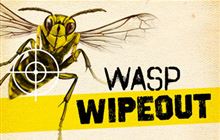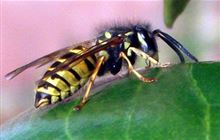Vespex wasp bait found safe for bee colonies
Archived content: This media release was accurate on the date of publication.
Introduction
A study has found use of the protein-based Vespex wasp bait for control of German and common wasps does not harm bee colonies.Date: 19 December 2018
Vespex wasp bait is an important wasp control tool for beekeepers to protect their bees from introduced wasps stealing honey and attacking bees. It is also used by community groups, the DOC and others where wasps are a nuisance to people and to protect native birds and insects from wasps.
In the Victoria University of Wellington and DOC study, no fipronil insecticide used in Vespex wasp bait was detected in a total of 480 worker bee, bee larva, honey and pollen samples collected over a two-year period from 30 hives which had wasp bait stations nearby.
The study was carried out by DOC scientist Eric Edwards and Victoria University of Wellington scientists Ethan Woolly, Rose McLellan and Dr Robert Keyzers.
Eric Edwards says Vespex wasp bait was considered safe for bees as it’s made from protein with no sugars and the research adds further weight to confirm it being unattractive to bees as they prefer sweet foods.
Testing of samples of bees, bee larvae, pollen and honey was carried out at the Victoria University of Wellington School of Chemical and Physical Sciences.
Dr Rob Keyzers says the test that was developed was sufficiently sensitive to be able to detect very small traces of fipronil, matching sensitivities reported in European field studies for agricultural uses of the insecticide and for laboratory testing of toxicities for bees.
A low level of a fipronil breakdown product was detected in initial testing of seven worker bees, but it wasn’t detected in two further tests of the same bee sample. The researchers concluded the derivative trace was likely just from a single bee and a rare occurrence given it wasn’t detected in follow up testing from the same sample or from any other hives sampled and it may not have come from Vespex wasp bait.
“Bees are social insects that share resources within their hives,” says Eric Edwards. “Foods are rapidly transferred within a hive environment between forager and nurse bees, bee larvae and products like honey. All of these were tested showing no evidence of transfer inside hives of the insecticide in the wasp bait.”
An economic impact analysis published in 2015 estimated $8.8 million in direct costs to beekeepers from wasp attacks with even higher costs from the impact on the services that bees provide.
The research report has been published by the Public Library of Science (PLOS) in the PLOS ONE open access scientific journal.
Additional information
Vespex wasp bait
Vespex wasp bait was developed by Nelson entomologist Richard Toft in conjunction with DOC. It was used in a pilot programme at five public conservation land sites in Nelson Tasman, Marlborough and Canterbury in early 2015 and became publicly available later that year.
Vespex wasp bait enables control of numerous wasp nests up to 200 m from a bait station. When carried out correctly, wasp activity is reduced by more than 90%.
Vespex wasp bait is applied when wasps are taking protein foods to feed their larvae. Wasps take the protein bait from bait stations back to their nests where they feed it to the larvae which digest and then share the food through the wasp colony, wiping out the nest.
Wasp Wipeout
Vespex wasp bait is used for wasp control in the Wasp Wipeout conservation project supported by Stuff in partnership with DOC and community groups that enables increased wasp control in some areas worst affected by wasps.
This summer, Wasp Wipeout will support increased wasp control in Nelson Tasman, Marlborough, Canterbury and the West Coast including at priority sites in national parks and on other public conservation land and at other places where wasps are a concern.
Wasps are pests
Introduced wasps are one of the most damaging insect pests in New Zealand where German and common wasp densities are some of the highest in the world.
A 2015 study estimated that they cost the New Zealand economy more than $130 million dollars a year. The biggest economic impacts are on farming, beekeeping, horticulture and forestry workers.
Wasps also have a major impact on New Zealand’s biodiversity, preying on native insects and taking honeydew in honeydew beech forests that is a valuable energy source for some forest birds.
Wasps have been observed killing bird chicks as they emerge from eggs.
Contact
For media enquiries contact:
Email: media@doc.govt.nz


